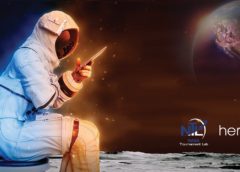HeroX, the social network for innovation and the world’s leading platform for crowdsourced solutions, today launched the crowdsourcing competition “Lunar Loo” on behalf of the NASA Tournament Lab (NTL) and NASA’s Human Landing System (HLS) Program. NASA is preparing to return to the Moon by 2024 and needs to develop a new way for astronauts to urinate and defecate in microgravity and lunar gravity. The crowdsourcing challenge calls on the global community of innovators to provide innovative design concepts for fully capable, low mass toilets that can be used both in space and on the moon.
Competitive toilet designs will align with NASA’s overall goals of reduced mass and volume, lower power consumption, and easy maintenance. Selected designs may be modified for integration into Artemis lunar landers. This effort is all part of NASA’s Artemis program to return astronauts to the moon in 2024.
During the eight-week challenge, problem solvers can win up to $35,000 in prizes.
“As NASA astronauts prepare to set their boots on the Moon in 2024, we’re turning to the global network of problem solvers to design the next-generation lunar toilet,” said Mike Interbartolo, project manager for the Lunar Loo Challenge in the HLS Crew Compartment Office at NASA’s Johnson Space Center. “As we prepare for this extraordinary event, we can’t forget about the ordinary needs of our astronauts.”
“NASA’s previous challenge, Space Poop, went viral, demonstrating how effective the power of the crowd is to solve galactic problems,” said Christian Cotichini, CEO, HeroX. “It’s always an honor helping solve ‘number two’ challenges.”
The Challenge: NASA is calling on the global community to submit their novel design concepts for compact toilets that can operate in both microgravity and lunar gravity. These designs may be adapted for use in the Artemis lunar landers that take humanity back to the Moon. Although space toilets already exist and are in use (on the International Space Station, for example), they are designed for microgravity only. NASA is looking for a next-generation device that is smaller, more efficient, and capable of working in both microgravity and lunar gravity. Getting back to the Moon by 2024 is an ambitious goal, and NASA is already working on approaches to miniaturize and streamline the existing toilets. But they also want ideas from people that will approach the problem with a mindset different from traditional aerospace engineering. This challenge hopes to attract radically new and different approaches to the problem of human waste capture and containment. And, to encourage the next generation of solvers, there will also be a Junior category for innovators under 18 years of age.
The Prize: The challenge will award $35,000 in prizes to the authors of the three most compelling design concepts. In addition to the awards, design winners will have the opportunity to talk directly with NASA engineers about their proposed toilet designs. The top three participants in the Junior category will each receive public recognition and an item of official NASA-logoed material.
How to Become a Solver: The prize is open to anyone aged 18 or older participating as an individual or as a team. Individual competitors and teams may originate from any country, as long as United States federal sanctions do not prohibit participation (some restrictions apply). To submit to the Junior category, you must be younger than 18.
To accept the challenge, visit https://www.herox.com/lunarloo
ABOUT HEROX
HeroX is a social network for crowdsourcing innovation and human ingenuity, co-founded in 2013 by serial entrepreneur, Christian Cotichini and XPRIZE Founder and Futurist, Peter Diamandis. HeroX offers a turnkey, easy-to-use platform that supports anyone, anywhere, to solve everyday business and world challenges using the power of the crowd. Uniquely positioned as the Social Network for Innovation, HeroX is the only place you can build, grow and curate your very own crowd.
Explore the latest challenges at www.herox.com
SOURCE HeroX


